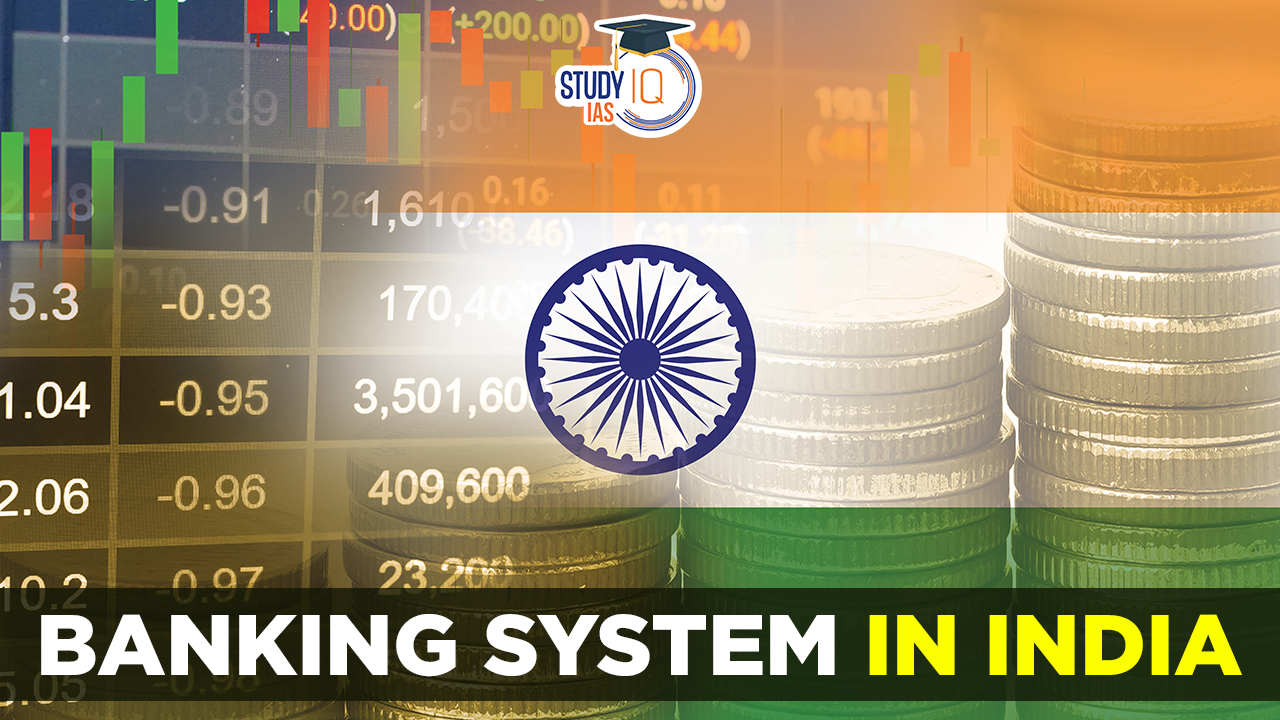Table of Contents
Banking System in India
The Banking System in India is a well-developed and regulated system that plays a crucial role in the country’s economy. It comprises various types of banks, including public sector banks, private sector banks, foreign banks, regional rural banks, and cooperative banks.
The Banking System in India offers a range of services, including savings accounts, current accounts, fixed deposits, loans, credit cards, mobile banking, internet banking, and various government-backed schemes for financial inclusion. The system has undergone several reforms over the years to enhance efficiency, transparency, and financial stability.
Read about: List of RBI Governors of India
Structure of Banking System in India
The Banking System in India has a hierarchical structure consisting of various types of banks. Here’s an overview of the structure of the banking system in India, which also includes legislation under which each type of bank operates:
| Level/Type | Description | Legislation |
| Reserve Bank of India | Central bank and apex regulatory authority for the banking system in India. | Reserve Bank of India Act, 1934 |
| Scheduled Commercial Banks | Refer to banks that are listed in the Second Schedule of the Reserve Bank of India (RBI) Act, 1934. | |
| Public Sector Banks (PSBs) | Owned and controlled by the government of India. | Banking Companies (Acquisition and Transfer of Undertakings) Act, 1970 and 1980 |
| Private Sector Banks | Owned and operated by private entities or individuals. | Banking Regulation Act, 1949 |
| Foreign Banks | Banks with headquarters outside India but operate branches in the country. | Banking Regulation Act, 1949 |
| Regional Rural Banks (RRBs) | Specialized banks providing services to rural and agricultural sectors. | Regional Rural Banks Act, 1976 |
| Cooperative Banks | Financial institutions are owned and operated by cooperative societies or groups of individuals. | Banking Regulation Act, 1949 (for urban cooperative banks) and State Cooperative Societies Acts (for rural cooperative banks) |
| Non-Banking Financial Companies (NBFCs) | Institutions providing banking and financial services without holding a banking license. | Reserve Bank of India Act, 1934 and the Companies Act, 2013 |
Read More: Types of Banks in India
Banking Sector Reforms in India
The banking sector in India has undergone significant reforms over the years to enhance efficiency, transparency, and stability. Here are some key banking sector reforms in India:
| Reforms | Description | Committee/Panel |
| Nationalization of Banks (1969 and 1980) | The government of India nationalized major commercial banks to increase banking penetration and promote social welfare. | Committee on the Structure of Commercial Banks (1969), and the Narasimham Committee (1980) |
| Liberalization and Deregulation (1991) | Economic liberalization and financial sector reforms aimed at promoting competition, attracting foreign investments, and strengthening the banking system. | Narasimham Committee I (1991) |
| Introduction of New Banks | RBI issued licenses for the establishment of new private-sector banks, promoting competition and innovation. | R. H. Khan Committee (1994) |
| Implementation of Prudential Norms | Introduction of capital adequacy requirements (Basel framework), asset classification and provisioning norms, risk management guidelines, and disclosure requirements. | Narasimham Committee II (1998) |
| Adoption of Core Banking Solutions (CBS) | Banks adopted CBS for centralized record-keeping, online transactions, and seamless integration across branches. | Indian Banks’ Association (IBA) |
| Introduction of Technology-based Services | Embracing technology for Internet banking, mobile banking, electronic fund transfers, and online payment systems. | Indian Banks’ Association (IBA) |
| Asset Quality Review (AQR) | RBI initiated AQR to assess banks’ health, identify non-performing assets (NPAs), and strengthen asset quality. | RBI Internal Committee (2014) |
| Insolvency and Bankruptcy Code (IBC) | Introduction of a legal framework for timely resolution of stressed assets and improved recovery of bad loans. | Joint Parliamentary Committee (2015) |
| Merger and Consolidation | Consolidation of public sector banks to create larger and stronger entities, enhancing operational efficiency and financial stability. | Committee of Ministers on Bank Consolidation (2017) |
| Bank Board Bureau (BBB) | An autonomous body that recommends appointments for top-level bank positions and helps in governance reforms. | Vinod Rai Committee (2014) |
Read More: Indian Financial System
Banking System in India History
The history of the banking system in India dates back several centuries. Here’s a brief overview of the key milestones in the history of banking in India:
Ancient and Medieval Periods (2000 BCE – 18th Century)
- Indigenous Banking: Ancient India had a well-established system of indigenous banking, with merchants and moneylenders providing financial services.
- Hundi System: The Hundi system, a form of a bill of exchange, was prevalent during this period and served as an early form of banking.
Colonial Era (18th Century – 1947)
- Establishment of Bank of Hindustan (1770): The Bank of Hindustan, considered the first bank in India, was established in Calcutta (now Kolkata) in 1770. It operated until 1832.
- Presidency Banks: Bank of Bengal (1806), Bank of Bombay (1840), and Bank of Madras (1843) were established as presidency banks, which acted as quasi-central banks in their respective regions.
- Allahabad Bank (1865): It was one of the oldest joint-stock banks in India, established in Allahabad.
- Cooperative Credit Societies Act (1904): This act paved the way for the formation of cooperative credit institutions to cater to the credit needs of farmers and rural areas.
Post-Independence (1947 – Present)
- Nationalization of Banks (1969 and 1980): The government of India nationalized major commercial banks in two phases to promote social welfare and increase banking penetration.
- Regional Rural Banks (1975): Regional Rural Banks were established to provide banking services to the rural and agricultural sectors.
- Lead Bank Scheme (1969): The Lead Bank Scheme aimed to ensure the provision of banking services to all areas of the country, with each district assigned to a lead bank.
- Liberalization and Privatization (1991 onwards): Economic reforms in 1991 led to the liberalization and opening up of the banking sector, allowing private and foreign banks to enter the market.
- Technology Adoption: Banks in India have embraced technology, introducing Internet banking, ATMs, electronic fund transfers, and mobile banking to enhance customer services and operational efficiency.
- Merger and Consolidation: In recent years, the government and the Reserve Bank of India have initiated the consolidation of public sector banks to create stronger and more efficient entities.
These are significant milestones in the history of the banking system in India. Over time, banking in India has evolved to become more inclusive, technologically advanced, and aligned with international standards.
Read about: Finance Ministers of India List
Banking System in India UPSC
The topic of the banking system in India is important for UPSC due to its relevance to Indian Economy and Governance, part of the UPSC Syllabus. Understanding the structure, functioning, and reforms of the banking system is crucial. UPSC Online Coaching and UPSC Mock Test provide comprehensive coverage, expert guidance, practice, and assessment to help aspirants prepare effectively for this topic.
Read about: India’s GDP Growth Rate


 Goods and Services Tax (GST), Objectives...
Goods and Services Tax (GST), Objectives...
 World Oceans Day 2025, History, Theme, S...
World Oceans Day 2025, History, Theme, S...
 World Environment Day 2025, Theme, Histo...
World Environment Day 2025, Theme, Histo...





















